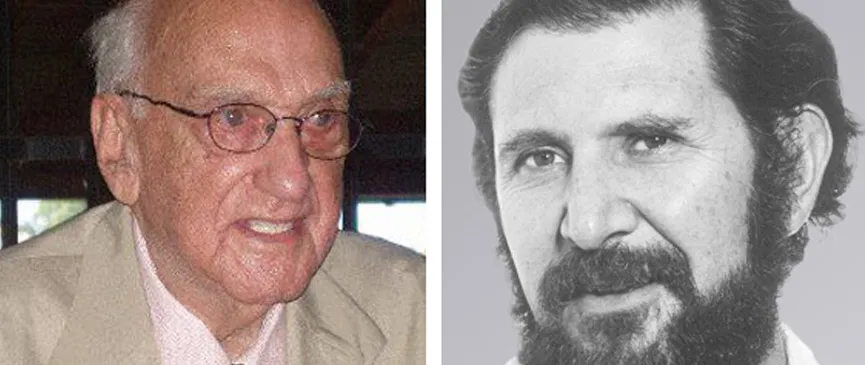Main content
Jacinto Convit and Pablo Rudomín Prince of Asturias Award for Technical & Scientific Research 1987

Doctor Pablo Rudomín is a researcher of worldwide renown, outstanding for his research in the field of neurophysiology.
Jacinto Convit (Venezuela, 1913) entered the Medicine Faculty of the Central University of Venezuela in 1932, where he subsequently earned a PhD in Medical Sciences. In 1937, he began working with Dr Martín Vegas, a pioneer in studies on leprosy. From then on, his work focused on finding a cure for this disease. After obtaining the tenured post of dermatologist at the Vargas Hospital in Caracas, he joined the Dermatology department headed by Professor Leopoldo Iragorry Briceño, being appointed head of the laboratory and instructor. Jacinto Convit was to hold this post until 1950, when he was appointed Head of Clinical Dermatology. From 1954 on, he worked as a lecturer and subsequently as a senior lecturer in the aforementioned Dermatology department. When most of the departments and lecturers of the Central University moved to the university district in 1958, Convit stayed on at the Vargas Hospital as head of the dermatology service and was also responsible for coordinating medical assistance, teaching and research activities in Dermatology. The advances made in the field of medical care, teaching and research earned him the international recognition of the American Board of Dermatology, which in 1965 designated the Department of Dermatology at the Vargas Hospital as a teaching centre for training resident doctors aspiring to obtain board certification. In 2011, at 98 years of age, he leads a team at the Vargas Hospital Institute of Biomedicine that is working on the development of an autogenous vaccine against breast, stomach and colon cancer. The procedure is based on scans combined with immunotherapy.
A specialist in parasitic diseases, he has devoted his entire life to developing different lines of research into the prevention and treatment of leprosy, leishmaniasis, onchocerciasis and mycosis, among other complaints of a similar nature. Especially recognized in this field as the discoverer of the cure for leprosy, his studies cover various aspects of the clinical nature, immunopathology, epidemiology, control and therapy of these diseases. He has published over 300 scientific papers.
Nominated for the Nobel Prize in Physiology or Medicine in 1988, the Venezuelan government awarded him an honourable mention in the 2009 National Award for Science, Technology and Innovation and, in 2011, he received the insignia of Officer of the French Order of the Legion of Honour.
Paul Rudomín Zevnovaty (Mexico, 1934) studied Biology at the National School of Biological Sciences of the National Polytechnic Institute (Spanish acronym, IPN), where he subsequently obtained his MSc Degree, specialising in Physiology. Since 1961, he has carried out his academic work at the Centre for Research and Advanced Studies (CINVESTAV) at the IPN and was director of the Neuroscience programme at this centre. He has been vice-president and subsequently president of the US Mexico Foundation for Science. In addition to his outstanding work as a researcher, Pablo Rudomín has carried out teaching work of great quality, having trained in his laboratory neurophysiologists who now work all over the world. He has been a visiting professor at the Rockefeller University, the Marine Biomedical Institute in Galveston, Texas, the National Institutes of Health in Bethesda, Maryland (USA), the Institute of Medical Pathology in Siena (Italy), the Hebrew University of Jerusalem, the University of Gothenburg (Sweden) and the John Curtin Medical School in Canberra (Australia).
He is considered one of the international community’s most prestigious neurophysiologists, having made important contributions in the field of the physiology of the spinal cord. His main interest has focused on the study of the presynaptic mechanisms that control synaptic transmission in vertebrates. Within this context, Dr Rudomín and his group have analysed in great detail the functional organisation of the segmental and supraspinal pathways that regulate the synaptic efficacy of sensory fibres originating from cutaneous and muscle receptors. His research has shown that the intraspinal terminals of sensory fibres are not required pathways for the flow of information from the periphery, but potential routes that the central nervous system itself can regulate so as to selectively activate specific populations of spinal neurons. Rudomín has served as a member of the editorial board on many of the most important journals in the field of neurophysiology, including Journal of Neurophysiology, Brain Research, Experimental Brain Research, Neurosciencies Letters and Neuroscience. He has also given a large number of conferences at various research centres both at home and abroad.
His scientific contributions have earned him distinctions such as the Natural Science Award of the Academy of Scientific Research of Mexico in 1972, and the National Science Award in 1979, the highest distinction granted by the Mexican government. In 1986, he was appointed to the Neurobiology advisory group of the US National Institutes of Health. That same year, he won the Medal of the Academy of Scientific Research of Mexico for the best work in Biomedical Sciences. In 1989, he received the Elizondo Prize, awarded by the Monterrey Institute of Technology, for the relevance of his scientific work. He became a member of the National College in 1993 and, three years later, was distinguished with the Lázaro Cardenas award granted by the National Polytechnic Institute and was named Researcher Emeritus at the Centre for Research and Advanced Studies of National Polytechnic Institute of Mexico and at the National System of Researchers Mexico. In 2002, he received the Krieg Achievement Award from the Ramón y Cajal International Association.
End of main content
